Holothuria (Mertensiothuria) leucospilota (Brandt, 1835)
 |
| Fig.1: Holothuria leucospilota (Brandt, 1835) at Tanjong Rimau, Sentosa, Singapore. Image by: Hazel Peh |
Overview | Distribution | Morphology | Potential Value | Conservation Status | Taxonomy & Systematics | Molecular Biology | Glossary | Additional Information | References
Overview
Holothuria (Mertensiothuria) leucospilota is a marine invertebrate, with a dark brown (almost black) body surface. It is approximately 40 to 50cm in length when full-grown, but can be elongated to almost a metre long [1]. It has a soft and pliable, cylindrical body covered with soft papillae [2].Why are we interested in them?
Ocean acidification has severely impacted coral reefs worldwide as a result of increasing CO2 levels and decreasing pH in seawater. This has caused the dissolution of calcium carbonate (CaCO3) that has severely affected reef-building organisms including corals and calcifying macroalgae.
A study by Schneider et al. has shown that Holothuria leucospilota as deposit feeders, ingest carbonate sand and rubble through their digestive tract and dissolves the sediment CaCO3 as part of their digestive processes [3]. Such activity allows for natural CaCO3 turnover and increased alkalinity, as the sea cucumber secretes ammonia (NH3, which becomes NH4+ in the aqueous medium) as a by-product of their digestive process. They contribute to the nutrient cycling process and enhance productivity in coral reefs, while buffering the seawater pH from ocean acidification [3]. Thus, Holothuria leucospilota can reduce the impact that ocean acidification has on coral reefs!
How do they feed?
Holothuria leucospilota are epibenthic, deposit feeding sea cucumbers. They actively feed on organic material in the sediment throughout the day using their oral tentacles [4]. Although they are often viewed as indiscriminate feeders, a study by Ong Che (1990) [5], has shown that this species actively selects smaller-sized grains and the selectivity is consistent across different substrate types. Their feeding habits are important for the bioturbation of marine sediments as they swallow a significant amount of sand, which eventually passes through the gut. For a closer look at their feeding tentacles, watch this video below!
How do they defend themselves?
Sea cucumbers, as well as other echinoderms including sea stars (Asteroidea), brittle stars (Ophiuroidea) and sea urchins (Echinoidea) carry out autotomy as a form of self-defense [4]. Autotomy is an extreme form of self-defense where the organism amputates its own body appendages or organs in response to stress [4].
In the case of Holothuria leucospilota, the species is capable of evisceration (a specialized form of autotomy). This process involves rupturing its cloaca and ejection of its internal organs including the gut, gonadal tubes and the respiratory trees [6,7]. A study by Hsieh (2012) has shown that approximately 28% of its body mass is eviscerated regardless of the organism size [4]. The same study showed that organ regeneration post-evisceration started with the thickening of the mesentery lining on the inner wall cavity as well as the thickening of the cuvierian tubules. This was then followed by the thickening of the digestive tract.
How do they reproduce?
Holothuria leucospilota have 2 modes of reproduction. They generally undergo asexual reproduction by transverse fission (Fig.2), although they are also capable of sexual reproduction [8,9]. Closer inshore and shallow-water, populations are denser and hence consist of smaller individuals that reproduce mainly by transverse fission.
A study conducted in Darwin, Australia, has shown that fission could occur regardless of the maturity stage of individuals [10]. On the other hand, scattered individuals from deeper or outer reef populations are larger and they reproduce sexually [11]. Sexual reproduction is characterized by “dioecism, external fertilization and a planktonic larval stage” [9,10]. The reproductive period of H. leucospilota is affected by environmental factors including water temperature and the timing of food resources [12]. In southern Taiwan (located at the northern limits of the tropics), H. leucospilota has an annual reproductive season, in late spring or summer, where environmental conditions are optimal for the development of planktonic larvae [12].
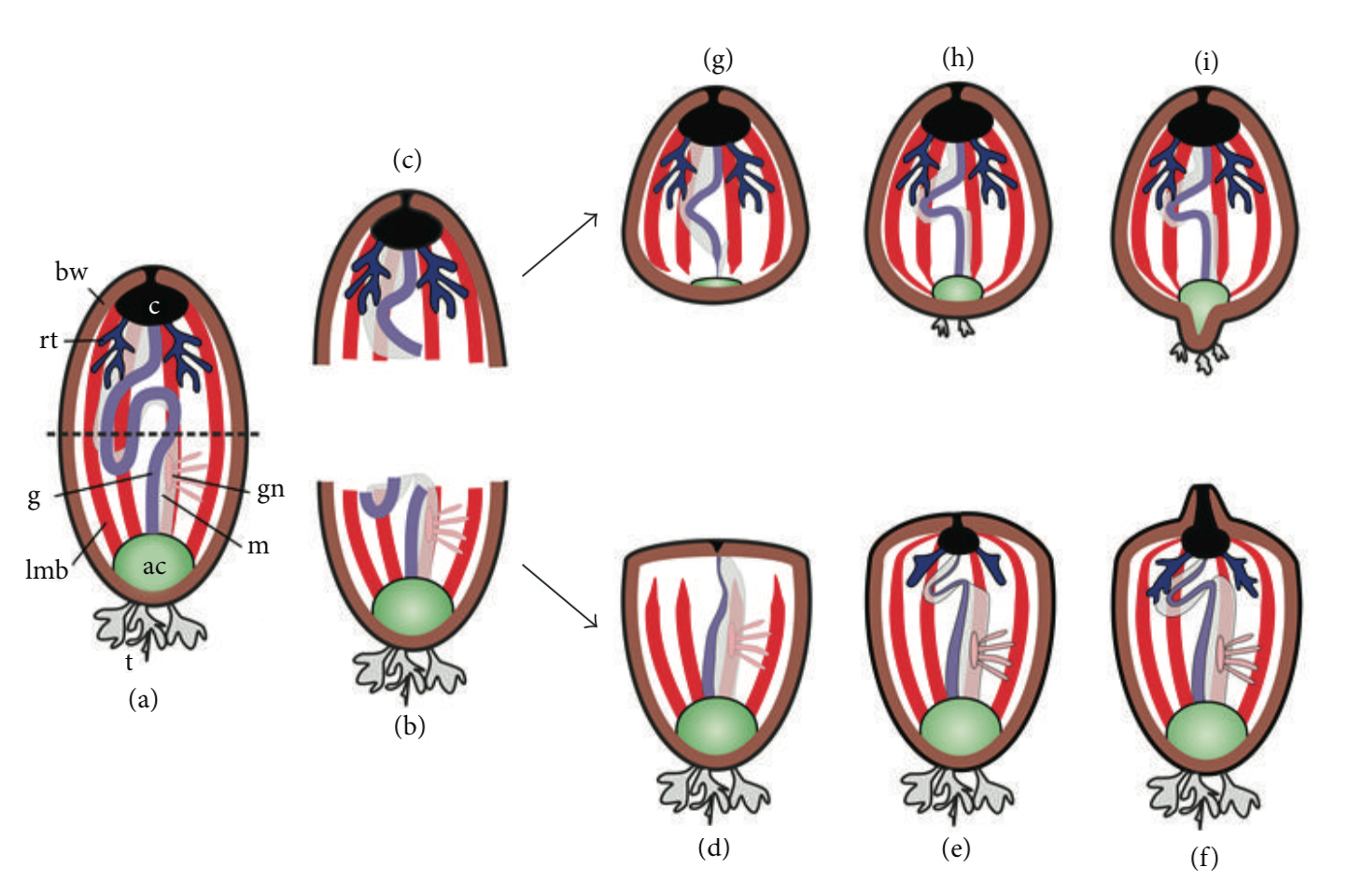 |
| Fig. 2: Scheme of internal organ regeneration after fission in holothurians. (a) Before fission. (b) & (c): Fragments just after fission. (d-i): Growth of remaining body parts. ac: aquapharyngeal complex, bw: body wall, c: cloaca, g: gut, gn: gonad, lmb: longitudinal muscle band, m: mesentery, rt: respiratory tree, t: tentacles. Illustration by: [7] Dolmatov (2014). |
What parasite lives in them?
Holothuria leucospilota is the specific host to the parasitic worm pearlfish (Encheliophis vermicularis). A study by Miyazaki et al. (2014) has suggested that pure saponins or triterpenoidal glycosides of the sea cucumber chemically attracts the pearlfish [13]. The fish enters the coelomic cavity of the sea cucumber via the anus without causing exudation of the cuvierian tubules [14]. It then lives within the gut of the sea cucumber and feeds on its internal organs including the respiratory tree and gonads [15]. Interestingly, the sea cucumber is able to “void their internal organs and subsequently regenerate them” [16]. It was also suggested that to minimize damage to their hosts, these pearlfishes move from one host to another [16].
Distribution
Where can they be found globally?
This species is widespread throughout the Indo-Pacific and the Red Sea. It can be found from South Africa to India, China to Australia, Hawaii, Polynesia, and east to Central America from Mexico to Peru [17]. The range map can be found here.
Where can they be found in Singapore?
In Singapore, Holothuria leucospilota is not common and is patchily distributed [18]. It is often found in the southern islands of Singapore as illustrated in the map below (Fig.3).
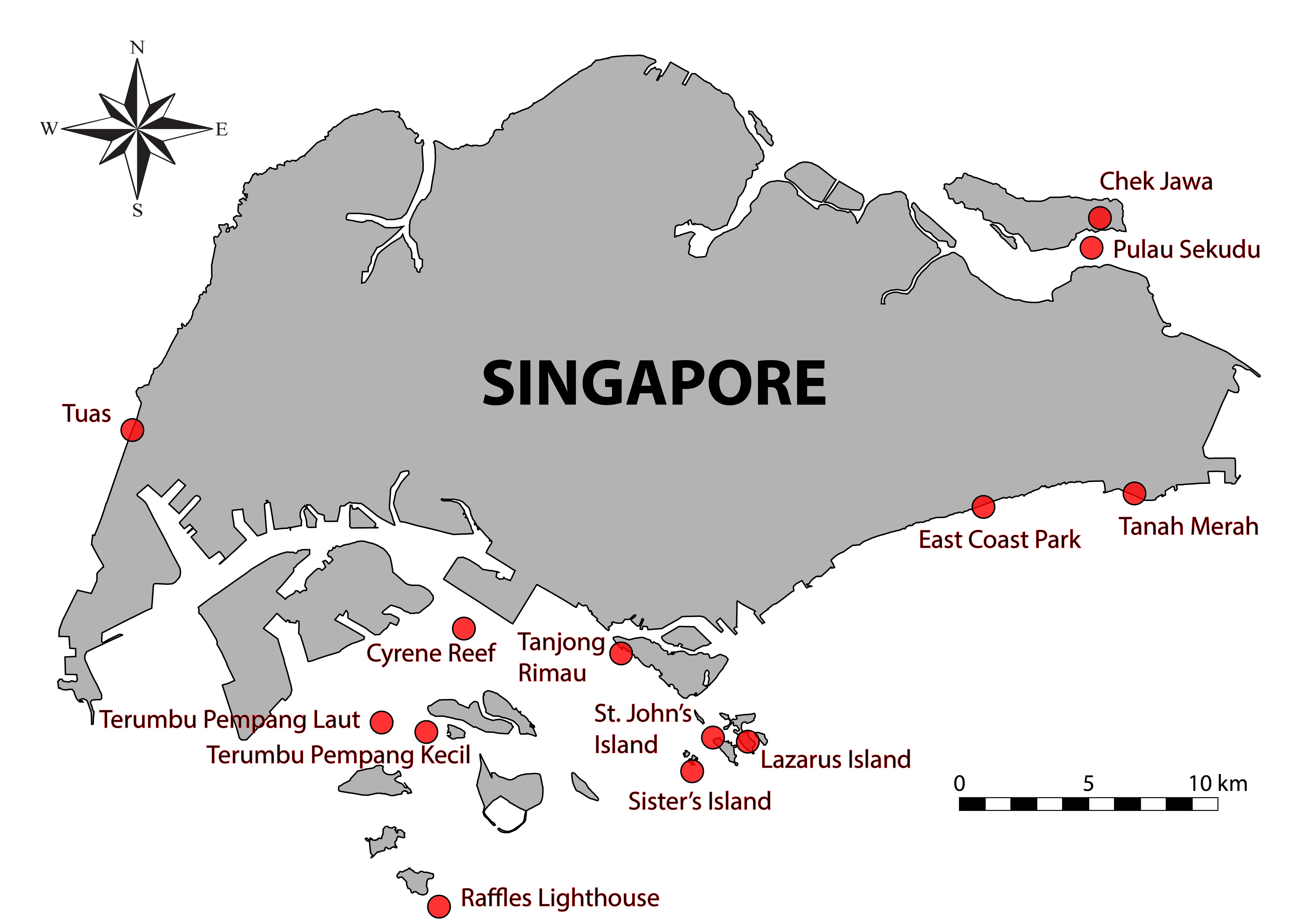 |
| Fig. 3: Distribution of Holothurian leucospilota around Singapore. Information retrieved from: WildSingapore. Map illustration by: Hazel Peh |
What habitat do they live in?
Holothuria leucospilota is widely distributed on reef flats throughout the tropical Indo-West Pacific [19]. It is usually found with its body partially hidden under large boulders or rocks [20]. It is also generally found in shallow waters, up to depths of up to 10m [21].
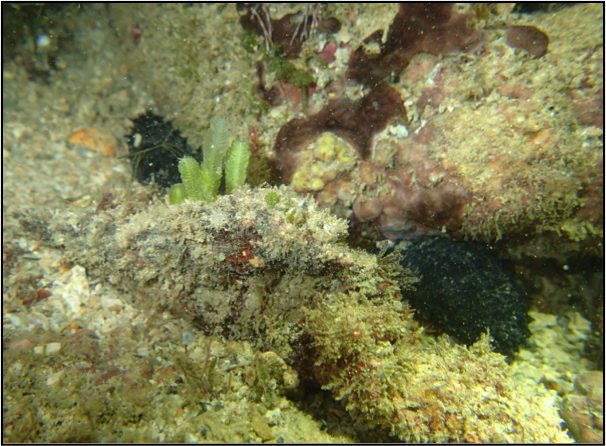 |
| Fig. 4: Holothuria leucospilota hidden beneath the substrate. Image by: Hazel Peh |
Morphology
Sea cucumbers or holothurians have orally-aborally elongated bodies and their gut lies in a coelomic cavity. Since they are invertebrates, they do not possess a backbone but they have reduced microscopic ossicles known as spicules on their body wall. Their mouth is encircled by tentacles and the anus is often edged by papillae [11]. Oral tentacles, primarily for feeding, are enlarged and modified tube feet that can either be dendritic (branching in an arborescent manner), peltate (flattened and shield-like), pinnate (feather-like) or digitate (finger-like projections) (Fig.5).
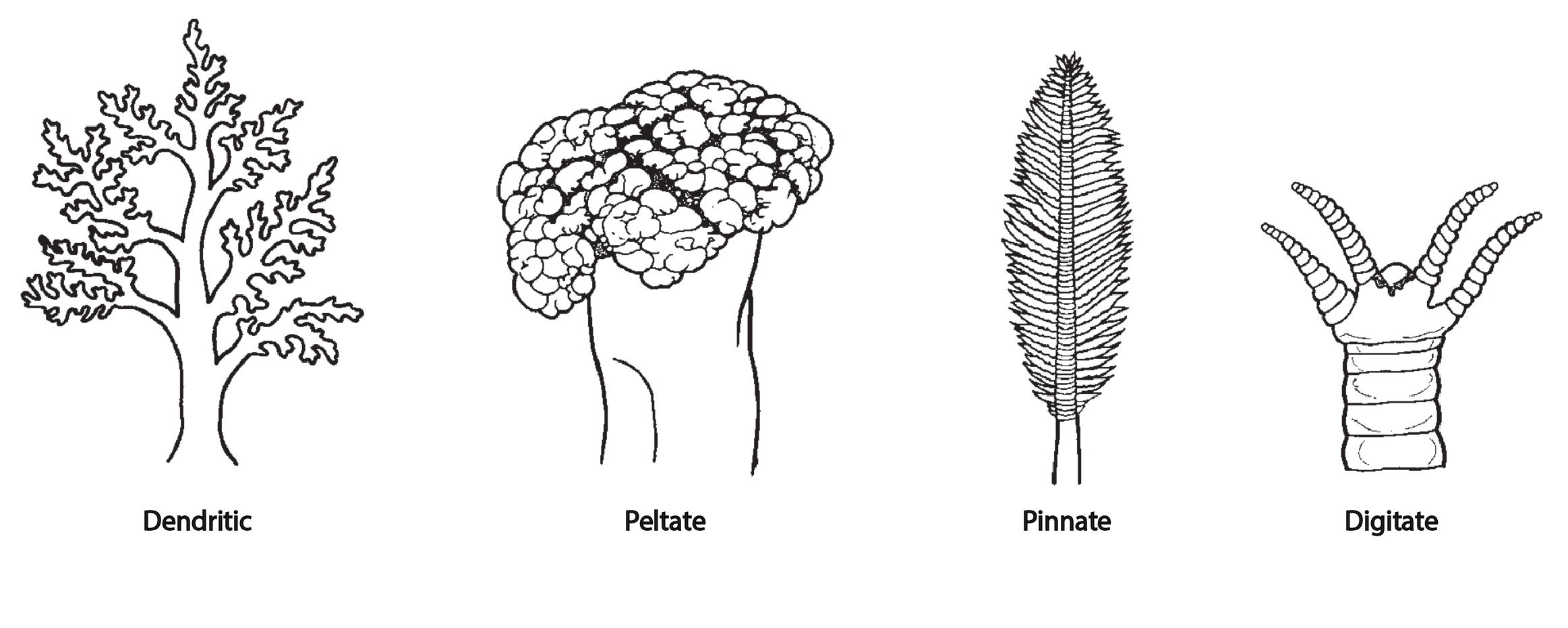 |
| Fig. 5: Basic types of tentacles that can be found in sea cucumbers [11] Conand (1998). |
They often lie on the substrate with their ventral surface (or trivium) that bears locomotory tube feet, while on their dorsal surface (or bivium), tube feet are often represented by papillae [11]. Holothurians also have a calcareous ring that encircles the pharynx, serving as an attachment point for muscles operating the oral tentacles and for the anterior ends of other muscles that contract the body longitudinally [22]. Many large holothurians have respiratory trees that perform gaseous exchange. The rete mirabile along the gut serves to distribute metabolites and nutrients throughout the organism [2]. Some holothurians possess cuvierian tubules, which are highly adhesive when ejected in water. This is part of their defence mechanism that allows them to entangle predators.
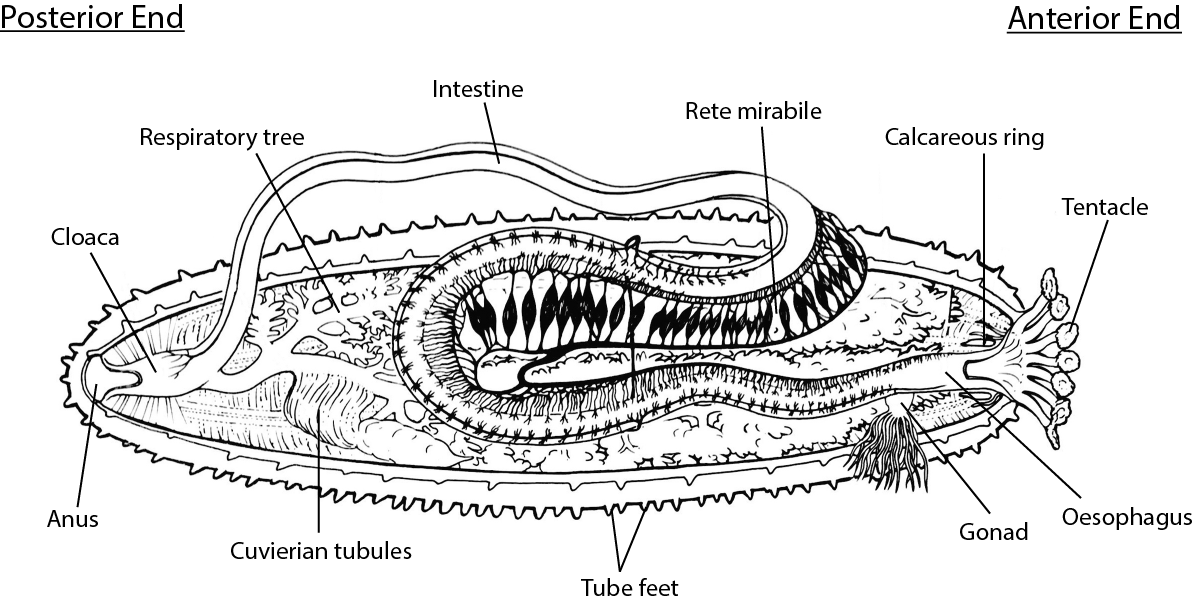 |
| Fig. 6: General anatomy of a sea cucumber. Illustration obtained from [2] Cannon & Silver (1986). Edited by: Hazel Peh |
How do we distinguish this species from other sea cucumbers?
To properly identify holothurians, there are several key features to be examined. Holothuria leucospilota can be easily identified in the waters of Singapore, although it is often misidentified as the Holothuria atra Jaeger, 1833 which is commonly found in the other parts of the Indo-Pacific region. For a pictorial key to confirm the identification of a sea cucumber, refer to this website. (N.B. This pictorial key is for Northern Australian sea cucumbers. Please use with discretion depending on your region.)
Table 1: Features distinguishing between Holothuria leucospilota and Holothurian atra.
[Information from Cannon & Silver 1986 [2], Conand 1998 [11] and James 1995 [20]. Illustration by Conand 1998 [11]. Photo of Holothuria atra by: © Florent Charpin (reefguide.org) Permission pending]
Distinguishing features |
(Black sea cucumber)Holothuria leucospilota |
(Lollyfish)Holothuria atra |
|
External |
Form |
Elongate; narrow anteriorly than posteriorly; tapered towards posterior end |
Cylindrical, elongate; rounded ends |
| Size |
Length: Commonly about 35cm (Up to 55cm)Live Weight: Approximately 0.3kg (Up to 8kg)Body wall thickness: About 3mm |
Length: Commonly about 20cm (Up to 45cm)Live Weight: Approximately 0.2kg (Up to 1kg)Body wall thickness: About 4mm |
|
| Tegument |
Very smooth |
Smooth, often covered in sand |
|
| Mouth |
Ventral, surrounded by 20 black, peltate (flattened and shield-like) tentacles |
Ventral, surrounded by 20 black, peltate tentacles |
|
| Anus |
Sub-dorsal |
Terminal |
|
Internal |
Cuvierian tubules |
Well- developed; very thin and long; readily ejected when it is under tactile stress |
Absent |
Calcareous ring |
Has large radial pieces and triangular interradials |
Has large radial pieces and narrow interradials |
|
Spicules* |
Tegument- Tables with circular large disc, having 8 or more holes; spire with 4 pillars, ending in a crown with a large central hole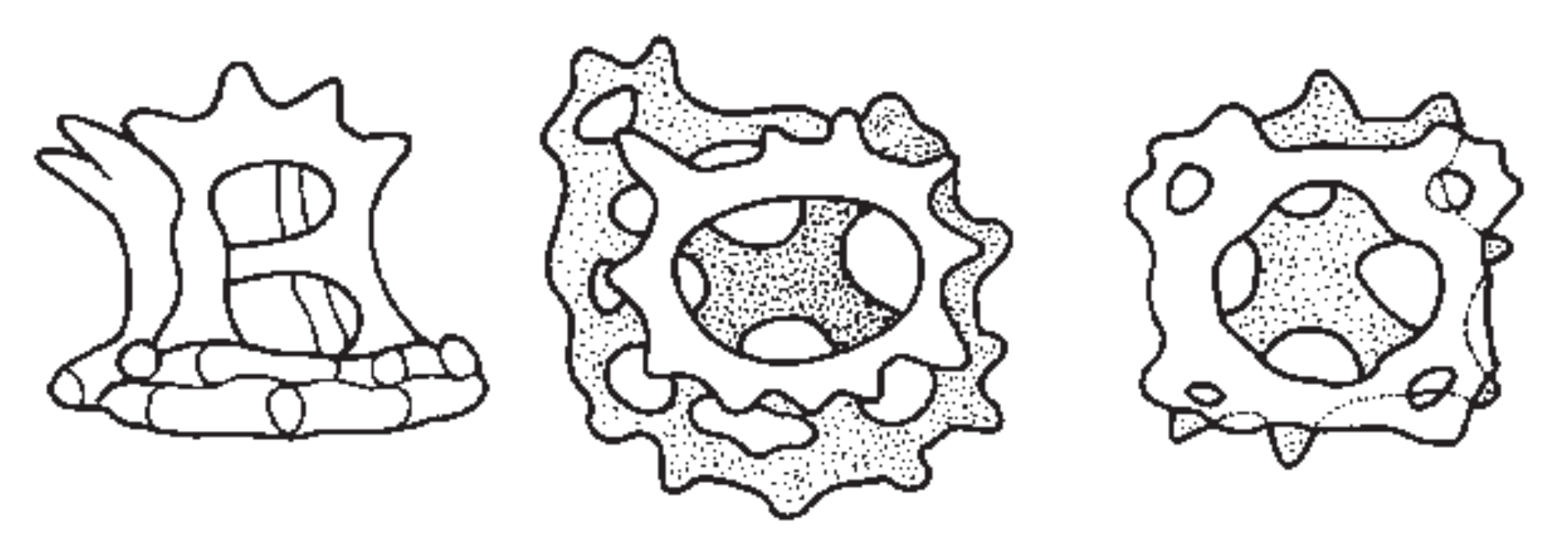 - Buttons are regular (with 6 or 8 holes) or irregular 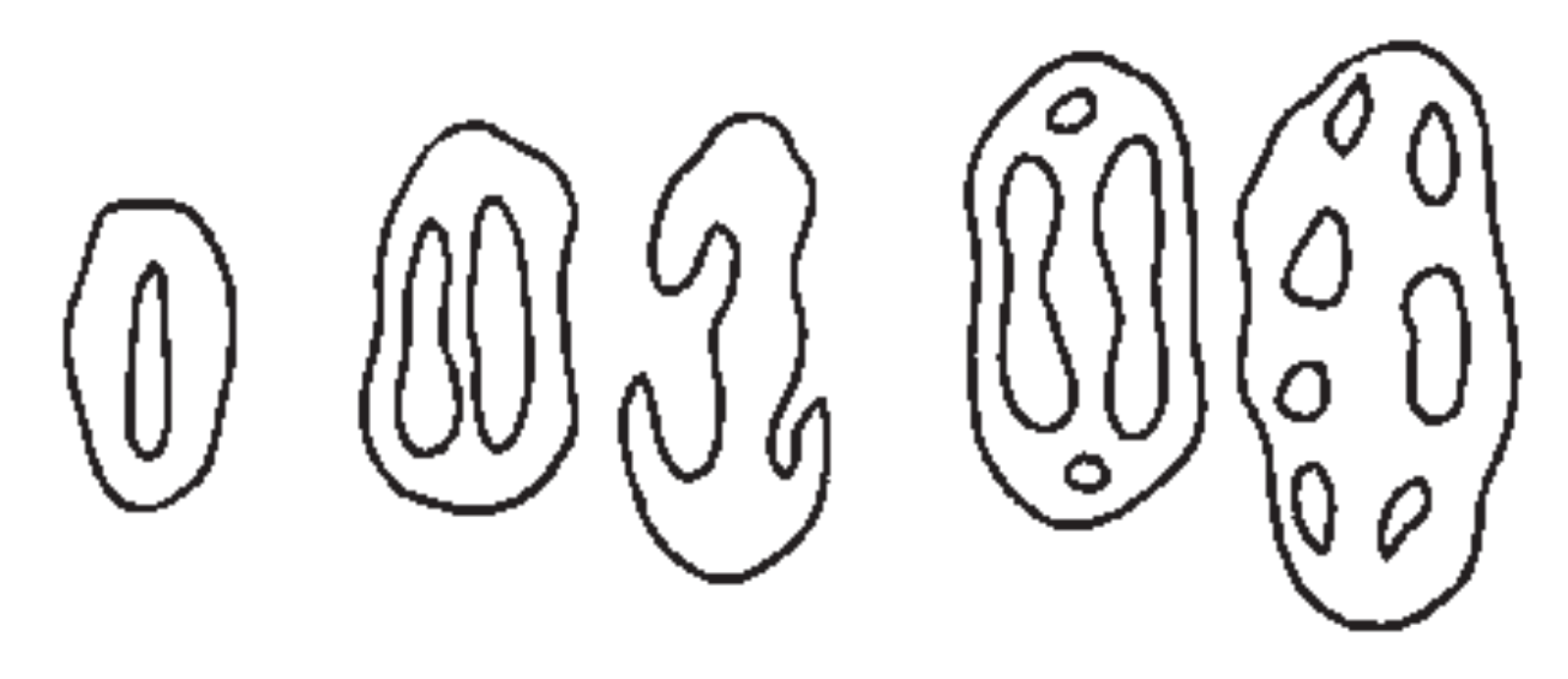 Ventral podia- Large plates with many holes 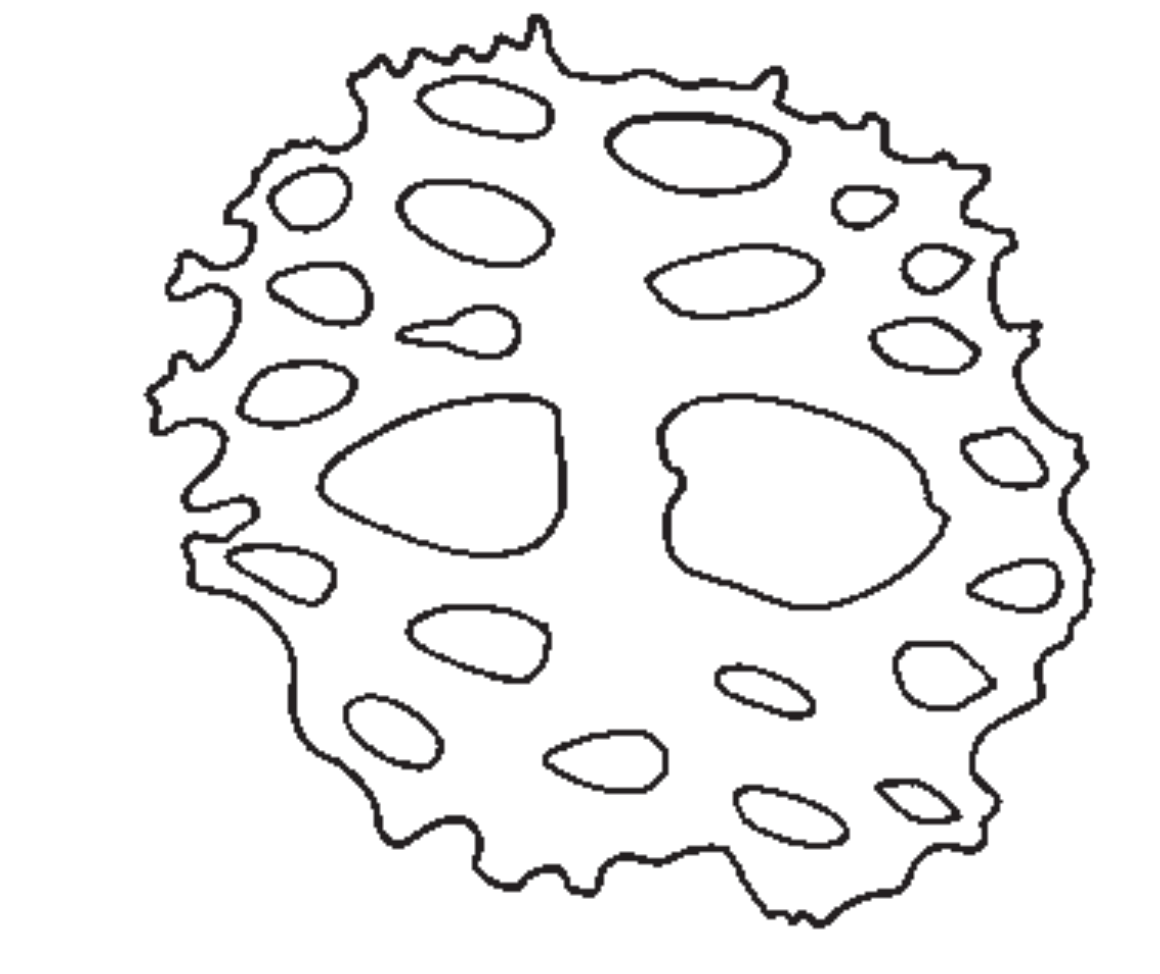 Dorsal podia- Long rods Tentacles- Few rods  |
Tegument- Tables with circular disc showing 8 holes (4 central and 4 smaller holes in between) and a spire of 4 pillars ending in a maltese crown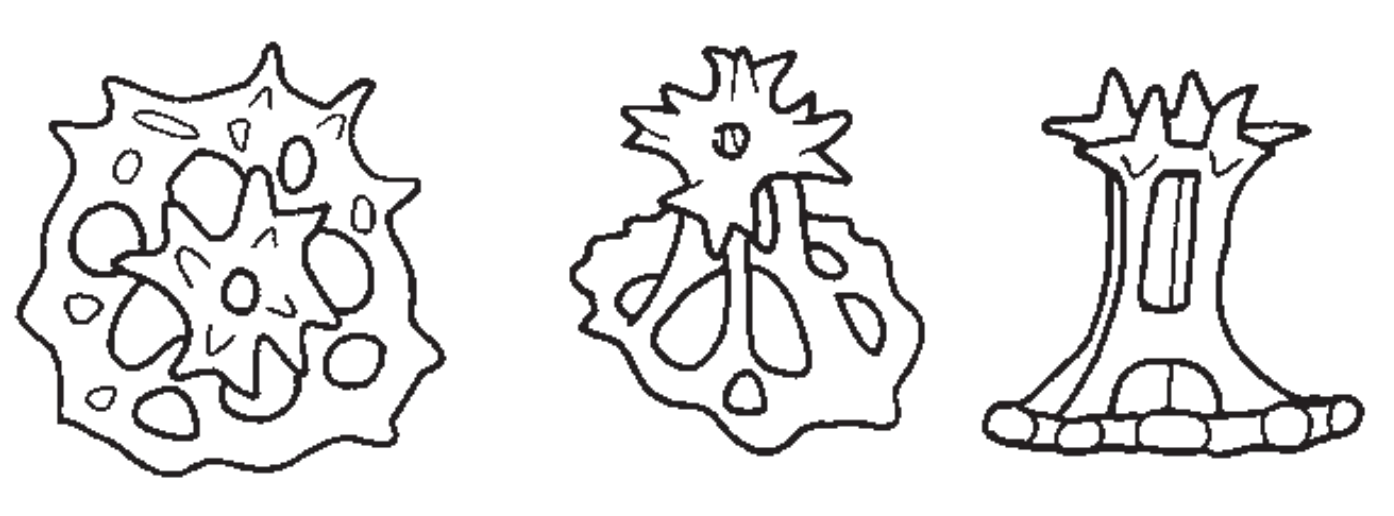 - Rosettes are small and simple; more abundant in ventral tegument 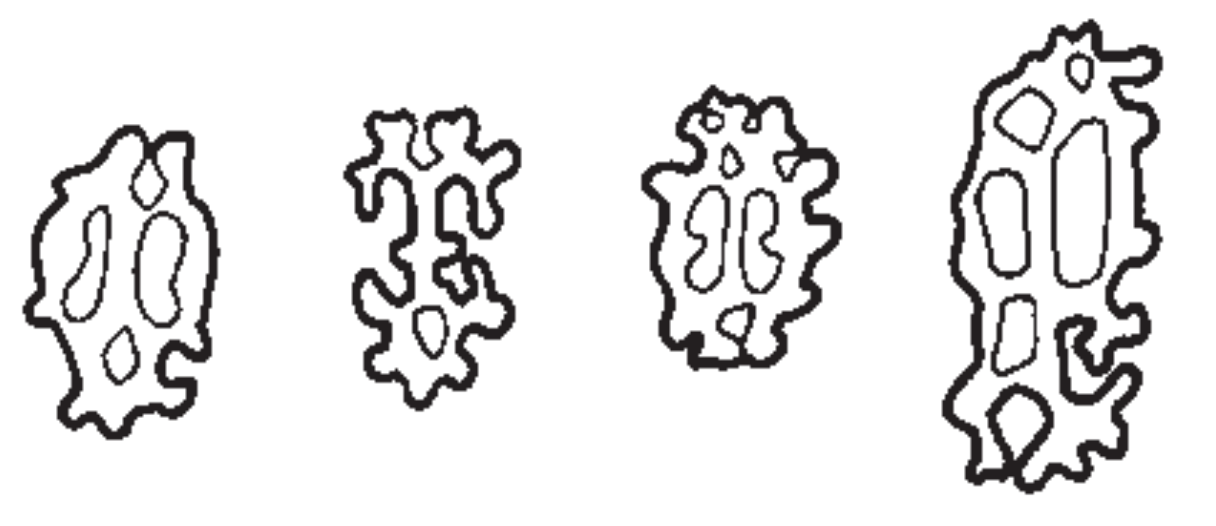 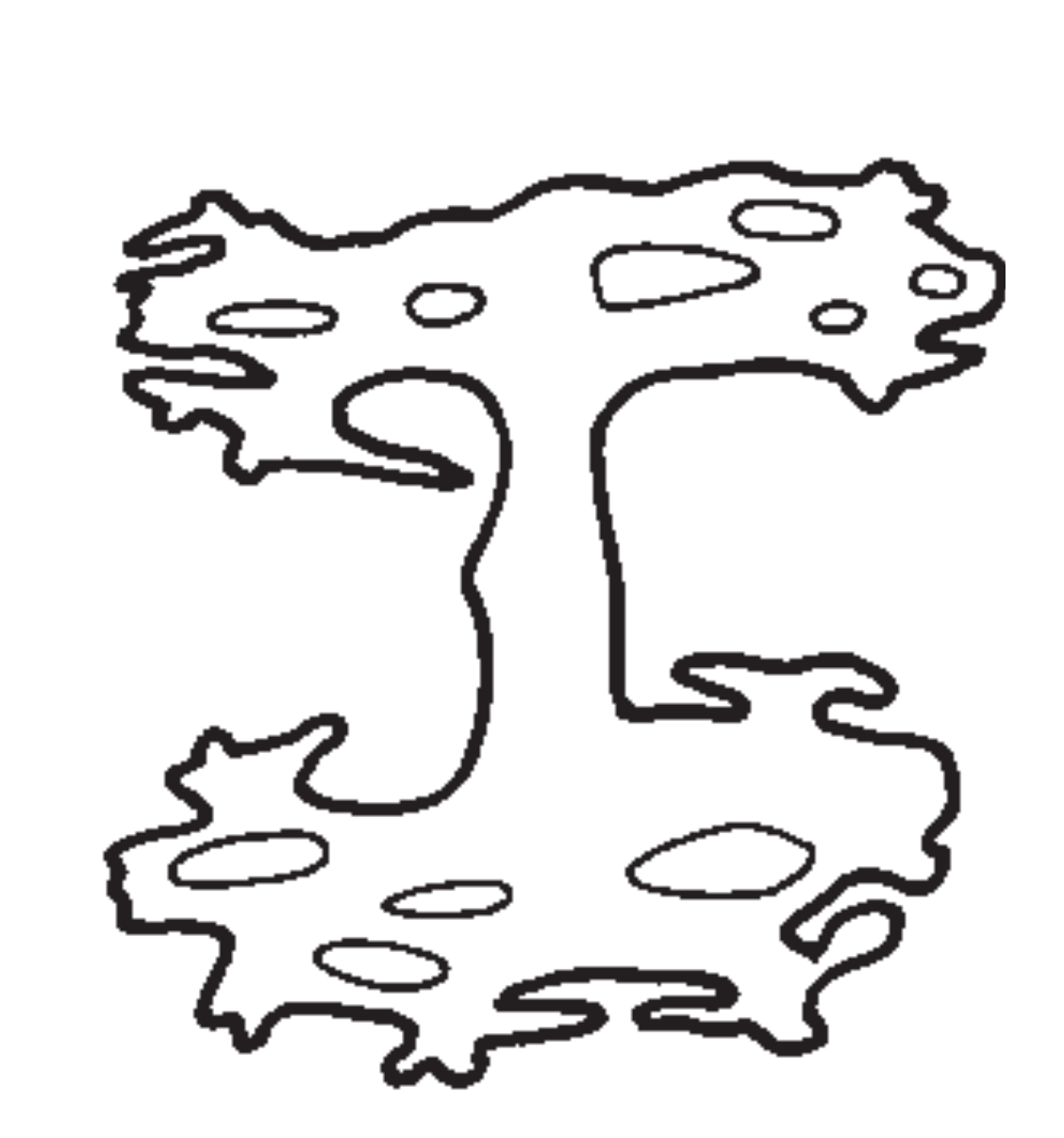 Dorsal podia- Short rods Tentacles 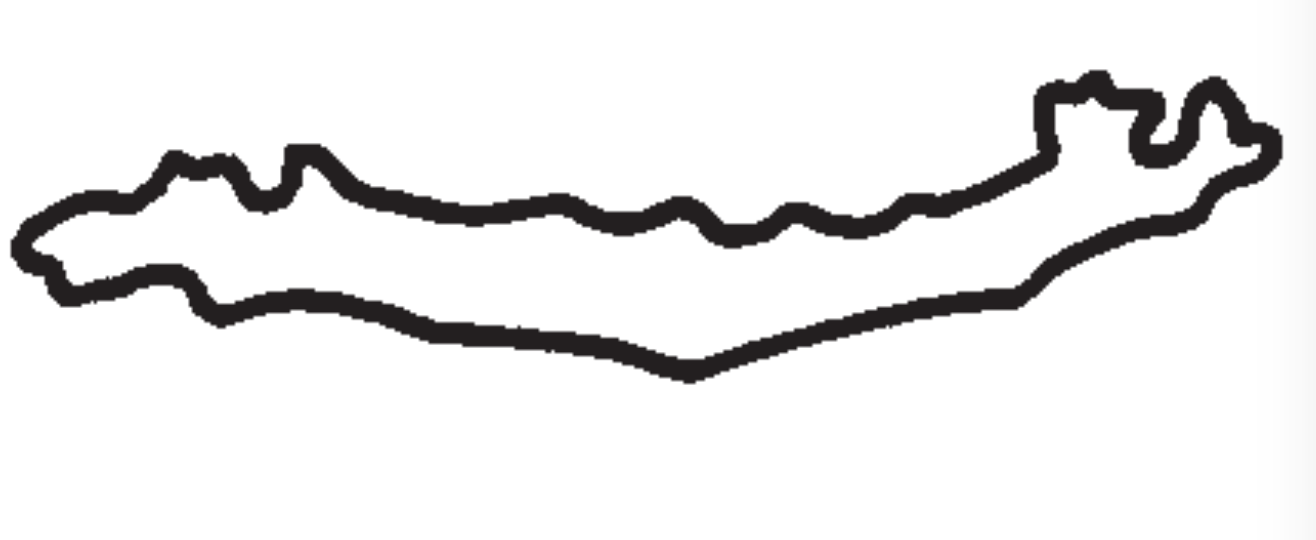 |
|
Others |
Toxicity |
Absence of red toxin |
Releases red toxin (known as holothurin or saponin) when handled or rubbed vigorously |
Potential Value
Isolated organs of Holothuria leucospilota have been found to contain significant antifungal and cytotoxic activity [23]. In the study, extracts from the sea cucumber showed full inhibition of fungal growth at the lowest concentration tested. This has implications on human health as sea cucumbers might in future provide a natural, alternative source of antimicrobial substance to combat antibiotic-resistant pathogens.
The sea cucumber has also been shown to contain three bioactive compounds (ganglioside molecular species: HLG-1, HLG-2, HLG-3) that were able to stimulate nerve cell growth in rat cells [24]. Another study also identified high antioxidant and antiproliferative activities of Holothuria leucospilota [25]. Aqueous extracts from the sea cucumber has shown high amounts of total phenolics and flavonoids, as well as high antioxidant activity in terms of linoleic acid peroxidation. A study by Ridzwan et al. (2003) has also exhibited that aqueous extracts of Holothuria leucospilota has antinociceptive effects on mice, which has proven the pain-relieving properties that the sea cucumber possesses as often claimed in folk medicine [26].
Conservation Status
Global
The status of Holothuria leucospilota on a global scale is listed as Least Concern (LC) on the IUCN Red List of Threatened species. This is because of its widespread distribution and it is also very common in some parts of its range [17]. Furthermore, it is not intensively fished due to its low commercial value. However, there are concerns that this species may become more popular as other species of higher commercial importance becomes depleted or reduced, such as the Holothuria scabra in Thailand [21].
Singapore
The status of H. leucospilota is listed as Vulnerable (VU) on the Red List of Threatened Animals in Singapore [18]. This is due to continued threats from continued coastal reclamation and developments, which has caused loss of populations of this species in several locations [19]. To prevent this species from going extinct in the wild, sizeable marine protected areas (MPAs) in the Southern Islands of Singapore has to be created [18].
Taxonomy & Systematics
Synonyms [27]
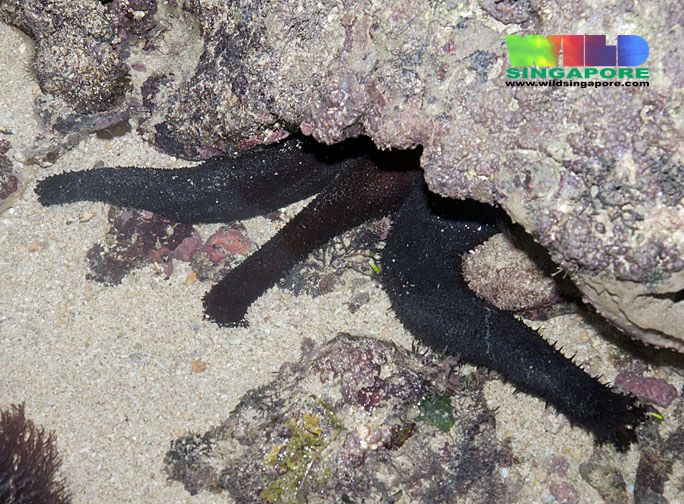 |
| Fig. 7: Holothuria leucospilota sometimes found in groups under rocks. Image taken with permission from: Ria Tan (WildSingapore) |
Holothuria (Halodeima) dicorona (Heding, 1934)
Holothuria gelatinosa Heding, 1939
Holothuria homoea Clark, 1938
Holothuria infesta Sluiter, 1901
Holothuria lamperti Ludwig, 1887
Holothuria oxurropa Sluiter, 1887
Holothuria lagoena Haacke, 1880
Holothuria vagabunda Selenka, 1867
Taxonomic classification
Phylum Echinodermata
Class Holothuroidea
Order Aspidochirotida
Family Holothuriidae
Genus Holothuria
Subgenus Mertensiothuria
Species Holothuria leucospilota
Taxonomic History
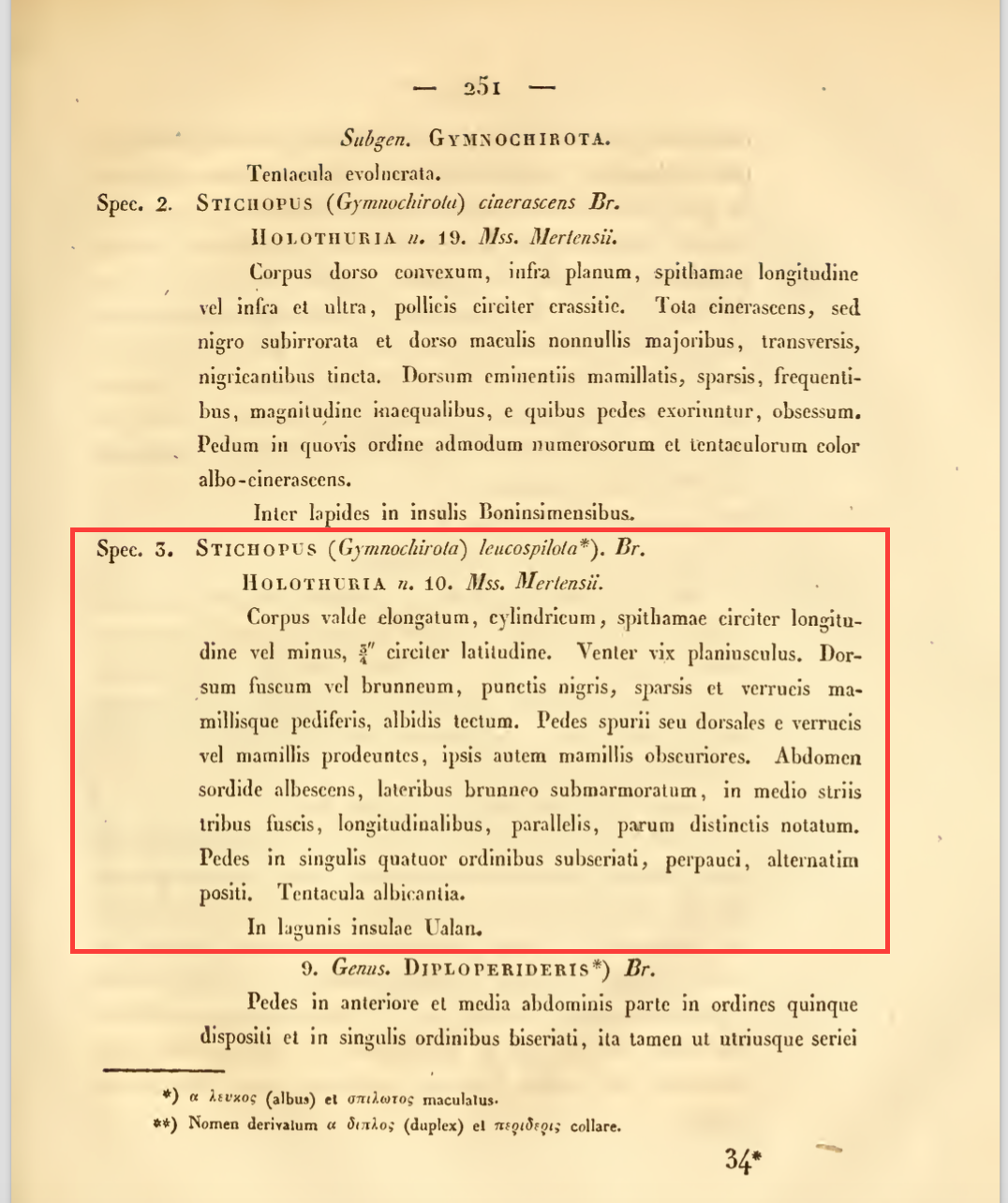 |
| Fig. 8: Original description of Holothuria leucospilota by Brandt, 1835. |
Holothuria (Mertensiothuria) leucospilota was originally Stichopus (Gymnochirota) leucospilota, described by Brandt, J.F. in 1835 (Fig. 8) [28].
Type information
The status and whereabouts of the type material of H. leucospilota is undetermined. Although the original type locality was Ualan, Marshall Islands, attempts to obtain specimens from there were unsuccessful [29]. Thus, the neotype was created from a specimen obtained from the Solomon Islands [30]. The specimen was kept as part of a collection in the Natural History Museum, London 1968.7.3.105–6. Based on article 76.3 of the International Code of Zoological Nomenclature, the Solomon Islands are the type locality of H. leucospilota [29].
This species is also the type species for the subgenus Mertensiothuria Deichmann, 1958 [29]. Mertensiothuria is one of the 20 subgenera recognized under Holothuria and to date, six valid species fall under subgenus Mertensiothuria [29].
Phylogeny
Although Rowe (1969) provided a tentative phylogeny based on ossicle similarity which suggested that the genus Holothuria was monophyletic [31], results presented in Kerr et al. (2005) showed that Holothuria was not a single lineage but a paraphyletic group that also gave rise to Pearsonothuria + Bohadschia and Labidodemas, regardless of the tree reconstruction method (Fig.9) [32].
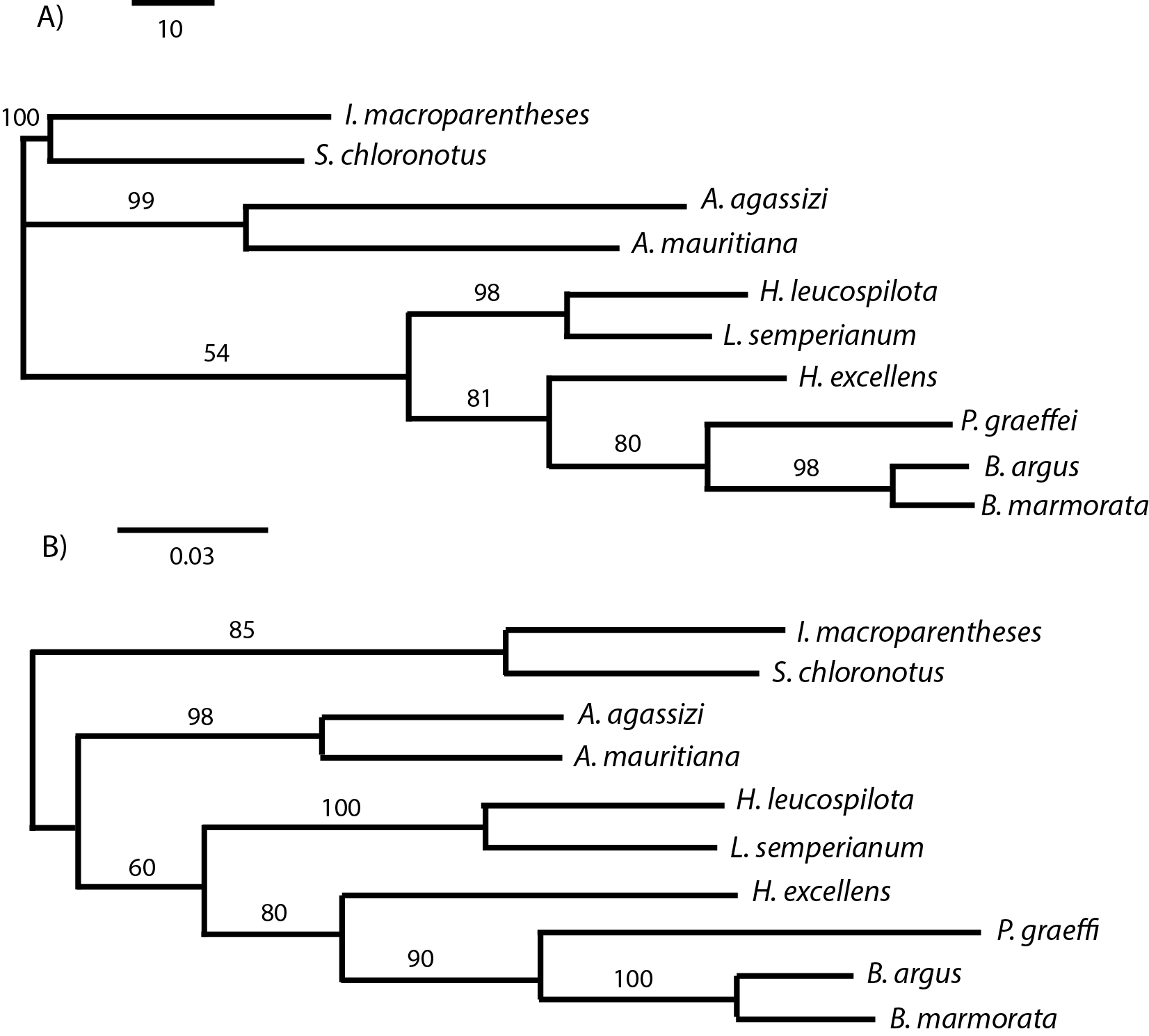 |
| Fig. 9: Phylogenetic trees. A) Single, most parsimonious tree using equal and transition-transversion weights (length, 407). B) Maximum likelihood tree (-ln L = 2509.670) [32] Kerr et al. (2005). |
A study conducted by Wen et al. (2011) aimed at developing a useful and reliable genetic method for the genetic identification of commercial sea cucumber species [33]. A ca. 570bp region of mitochondrial large ribosomal RNA (16S rRNA) gene was selected as the molecular marker. This was because the 16S rRNA gene is well conserved compared to other mitochondrial regions and it evolves faster than nuclear genes, thereby allowing genetic identification of closely related species. The study showed that samples of the same species were grouped in the same clade, allowing the differentiation of all the species included in the present study (Fig.10).
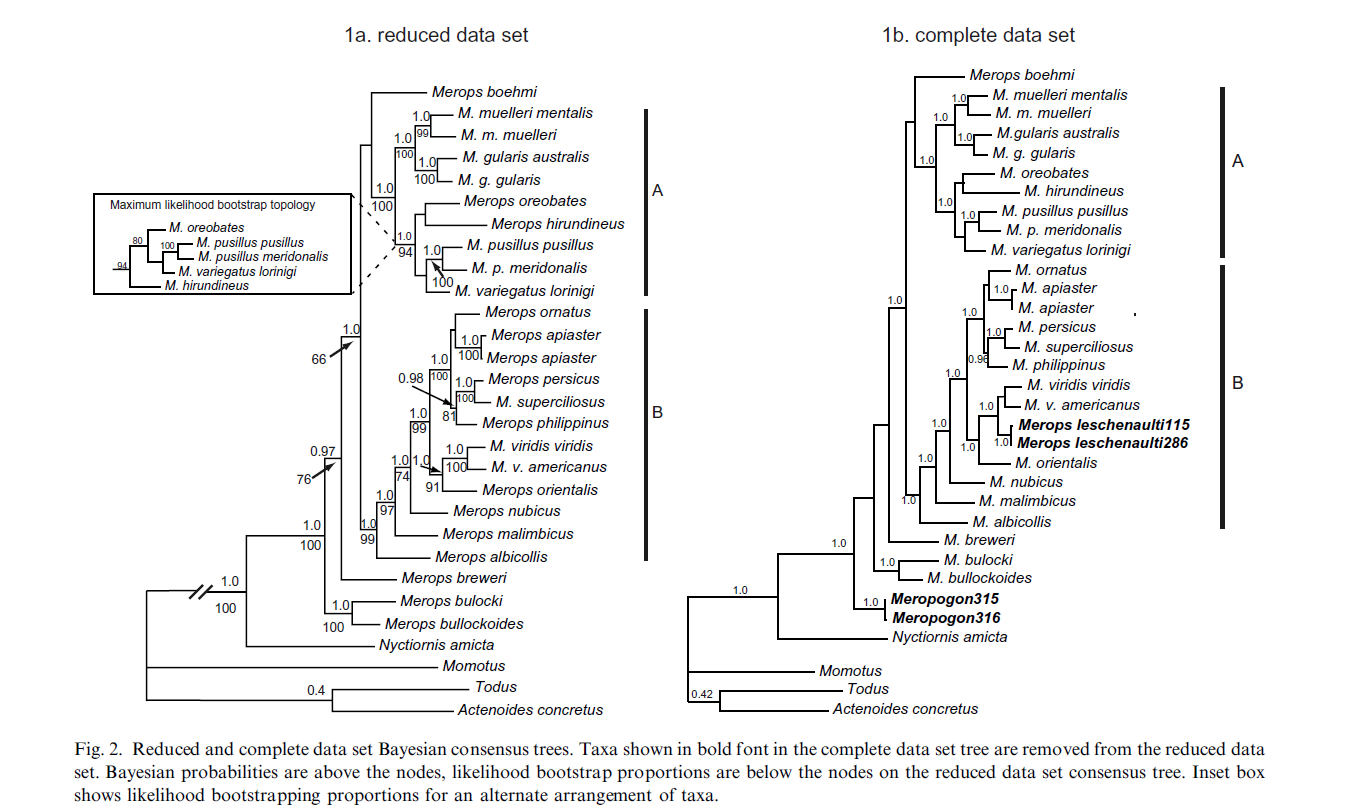 |
| Fig. 10: Molecular phylogenetic tree in the global commercial sea cucumber species based on Neighbour-joining analyses of 16S rRNA gene sequences. Numbers above branches indicate bootstrap values (percentage of 1000 replicates) higher than 85 from Neighbor-joining analysis. The NCBI accession numbers behind the species indicate the representative sequence of 16S rRNA gene. G1, G2, and G3 were the three taxonomic groups studied: families Caudinidae (G1), Holothuriidae (G2) and Stichopodidae (G3). Clades 1–4 are the four genera Holothuria (Clade 1), Bohadschia (Clade 2), Actinopyga (Clade 3) and Stichopus (Clade 4) [33] Wen et al. (2011). |
Molecular Biology
Two barcode sequences for this species are available from Barcode of Life Data Systems (BOLD) and GenBank.
The barcode region cytochrome oxidase subunit 1 (COI or COX1) from a member of H. leucospilota can be obtained from here.
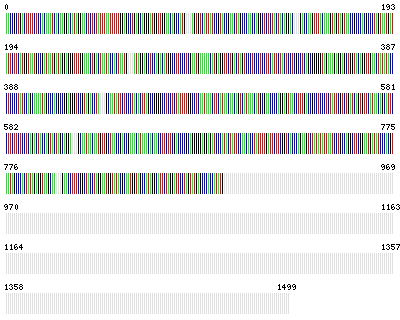 |
| Fig. 11: Representative barcode sequence of Holothuria leucospilota (the centroid of all available sequences for this species). Retrieved from the Barcode of Life Data Systems [34] . |
Glossary
Antinociceptive: Reducing sensitivity to painful stimuli.
Bioturbation: This is a process that allows reworking of the sediments, increasing sediment turnover rate and promoting oxidation of anoxic layers of sand.
Calcareous ring: This ring serves as an attachment point for muscles operating the oral tentacles and for the anterior ends of other muscles that contract the body longitudinally.
Cloaca: Posterior opening that serves as the opening for the intestinal and reproductive tracts of certain animal species.
Cuvierian tubules: Organs found in several species of sea cucumbers, all belonging to the family Holothuriidae (order Aspidochirotida). There are two main types of tubules; Holothuria leucospilota has smooth tubules that appear as long, sticky, white threads.
Dioecism: Individuals of a species are of one of two distinct sexes (either male or female); the more common term to use in the animal kingdom is 'gonochorism'.
Epibenthic: Living on the bottom surface.
Monophyletic: A group composed of a collection of organisms, including the most recent common ancestor of all those organisms and all the descendants of that most recent common ancestor.
Neotype: A new type specimen that is chosen to replace the pre-exisiting type specimen that has been misplaced or destroyed.
Papillae: Fleshy projections of the body wall, usually conical, with a sensory tube foot at its apex.
Paraphyletic: A group composed of a collection of organisms, including the most recent common ancestor of all those organisms but does not include all the descendants of the most recent common ancestor.
Rete mirabile: A fine network of haemal tissue that lies along the gut and functions to disperse nutrients and metabolites.
Spicules: These are also known as ossicles or deposits that function as supporting structures in invertebrates. They are either calcareous or siliceous.
Transverse fission: Splitting of the organism along the short axis of the body into two organisms.
Additional Information
To find out more about the species, do check out some of these interesting websites:1. WildSingapore2. HKmarinelife3. For brief information about sea cucumbers as food and medicine
Check out some of these videos too:1. For a closer look at the oral tentacles 2. For information about the black market for sea cucumbers
References
[1] Clark, H. L., 1946. The echinoderm fauna of Australia. Carnegie Institution of Washington, Washington, D.C, pp. 383–461.
[2] Cannon, L. R. G. & H. Silver, 1986. Sea Cucumbers of Northern Australia. Queensland Museum, South Brisbane, Australia, pp. 1–25.
[3] Schneider, K., J. Silverman, E. Woolsey, H. Eriksson, M. Byrne & K. Caldeira, 2011. Potential influence of sea cucumbers on coral reef CaCO3 budget: A case study at One Tree Reef. Journal of Geophysical Research, 116(G4): 2005–2012.
[4] Hsieh, V., 2012. Monitoring organ regeneration of sea cucumber Holothuria leucospilota after evisceration. Student Research Papers, Fall 2012. University of California, Berkeley, 11 pp.
[5] Ong Che, R. G., 1990. Aspects of the feeding biology of Holothuria leucospilota Brandt (Echinodermata: Holothuroidea) in Hong Kong. Asian Marine Biology, 7:133–146.
[6] Wilkie, I. C., 2001. Autotomy as a prelude to regeneration in echinoderms. Microscopy Research and Technique, 55(6): 369-396.
[7] Dolmatov, I. Y., N. A. Khang & Y. O. Kamenev, 2014. Asexual reproduction, evisceration, and regeneration in holothurians (Holothuroidea) from Nha Trang Bay of the South China Sea. Russian Journal of Marine Biology, 38(3): 243–252.
[8] Purwati, P., 2001. Reproduction in Holothuria leucospilota in the tropical waters of Darwin, NT, Australia. MSc Thesis. Northern Territory University, Australia, 147 pp.
[9] Taquet, C., F. Setiawan, N. Yasuda, Suharsono & K. Nadaoka, 2011. First observation of a large group of Holothuria leucospilota sea cucumber juveniles at a nursery in Manado (north Sulawesi, Indonesia). SPC Beche-de-mer Information Bulletin, 31:30–34.
[10] Purwati, P. & J. T. Luong-van, 2003. Sexual reproduction in a fissiparous holothurian species, Holothuria leucospilota Clark 1920 (Echinodermata: Holothuroidea). SPC Beche-de-mer Information Bulletin, 18:33–38.
[11] Conand, C., 1998. Holothurians. In: K. E. Carpenter & V. H. Niem (eds.) FAO species identification guide for fishery purposes. The living marine resources of the Western Central Pacific. Volume 2. Cephalopods, crustaceans, holothurians and sharks. Food and Agriculture Organization of the United Nations, Rome, pp. 1158–1184.
[12] Chao, S. M., C. P. Chen & P. S. Alexander, 1995. Reproductive cycles of tropical sea cucumbers (Echinodermata: Holothuroidea) in southern Taiwan. Marine Biology, 122: 289–295.
[13] Miyazaki, S., T. Ichiba, J. D. Reimer & J. Tanaka, 2014. Chemoattraction of the pearlfish Encheliophis vermicularis to the sea cucumber Holothuria leucospilota. Chemoecology, 24(3): 121–126.
[14] Smith, C. L., J. C. Tyler & M. N. Feinberg, 1981. Population ecology and biology of the pearlfish (Carapus bermudensis) in the lagoon at Bimini, Bahamas. Bulletin of Marine Science, 31: 876–902.
[15] Murdy, E. O. & M. E. Cowan, 1980. Observations on the behaviour and symbiotic relationship of the pearlfish Encheliophis vermicularis (Osteichthys: Carapidae). Kalikasan, 9(2): 309–312.
[16] Woodland, D., 2005. Parasitic marine fishes. In: K. Rohde (ed.) Marine Parasitology, Collingwood, Victoria, pp. 250–258.
[17] Conand, C., S. Purcell & R. Gamboa, 2013. Holothuria leucospilota. The IUCN Red List of Threatened Species. Version 2014.2. http://www.iucnredlist.org/details/180375/0 (Assessed 20 October 2014).
[18] Lane, D. J. W., 2008. Echinodermata. In: G. W. H. Davison, P. K. L. Ng & H. H. Chew (eds.) The Singapore Red Data Book: Threatened plants & animals of Singapore. The Nature Society, Singapore, p. 138.
[19] Lane, D. J. W. & D. Vandenspiegel, 2003. A guide to sea stars and other echinoderms of Singapore. Singapore Science Centre, Singapore, p. 146.
[20] James, D. B., 1995. Taxonomic Studies on the species of Holothuria Linnaeus, 1767 from the seas around India. Journal of the Bombay Natural History Society, 92(2): 190–204.[[#James 1995][7] Conand, C., S. Purcell & R. Gamboa, 2013. Holothuria leucospilota. The IUCN Red List of Threatened Species. Version 2014.2. http://www.iucnredlist.org/details/180375/0 (Assessed 20 October 2014).
[21] Choo, P. S, 2008. Population status, fisheries and trade of sea cucumbers in Asia. In: V. Toral-Granda, A. Lovatelli, and M. Vasconcellos (eds.) Sea cucumbers. A global review of fisheries and trade. FAO Fisheries and Aquaculture Technical Paper, Rome, pp. 81–118.
[22] Kerr, A. M., 2000. Holothuroidea. Sea cucumbers. The Tree of Life Web Project. http://tolweb.org/Holothuroidea/19240/2000.12.01 (Assessed 1 November 2014).
[23] Mohammadizadeh, F., M. Ehsanpor, M. Afkhami, A. Mokhlesi, A. Khazaali & S. Montazeri, 2013. Antibacterial, antifungal and cytotoxic effects of a sea cucumber Holothuria leucospilota, from the north coast of the Persian Gulf. Journal of the Marine Biological Association of the United Kingdom, 93(5): 1401–1405.
[24] Yamada, K., R. Matsubara, M. Kaneko, T. Miyamoto & R. Higuchi, 2001. Constituents of Holothuroidea. 10. 1) Isolation and structure of a biologically active ganglioside molecular species from the sea cucumber Holothuria leucospilota. Chemical and Pharmaceutical Bulletin, 49(4): 447–452.
[25] Althuibat, O. Y., R. B. Hashim, M. Taher, J. M. Daud, M. A. Ikeda & B. I. Zali, 2009. In vitro antioxidant and antiproliferative activities of three Malaysian sea cucumber species. European Journal of Scientific Research, 37(3): 376–387.
[26] Ridzwan, B. H., T. C. Leong & S. Z. Idid, 2003. The antinociceptive effects of water extracts from sea cucumbers Holothuria leucospilota Brandt, Bohadschia marmorata vitiensis Jaeger and coelomic fluid from Sticophus hermanii. Pakistan Journal of Biological Sciences, 6(24): 2068–2072.
[27] Paulay, G., 2014. Holothuria (Mertensiothuria) leucospilota (Brandt, 1835). http://www.marinespecies.org/aphia.php?p=taxdetails&id=210881 (Assessed 21 October 2014).
[28] Brandt, J. F., 1835. Prodromus descriptionis animalium ab H. Mertensio observatorum : fascic. I. Polypos, Acalephas Discophoras et Siphonophoras, nec non Echinodermata continens. Sumptibus Academiae, p.251.
[29] Samyn, Y. & C. Massin, 2003. The holothurian subgenus Mertensiothuria (Aspidochirotida: Holothuriidae) revisited. Journal of Natural History, 37(20): 2487–2519.
[30] Samyn, Y., 2003. Shallow-water Holothuroidea (Echinodermata) from Kenya and Pemba Island, Tanzania. Studies in Afrotropical Zoology, 292: 9–47.
[31] Rowe, F., 1969. A review of the family Holothuriidae (Holothurioidea: Aspidochirotida). Bulletin of the British Museum (Natural History), 18:7–170.
[32] Kerr, A. M., D. A. Janies, R. M. Clouse, Y. Samyn, J. Kuszak, & J. Kim, 2005. Molecular phylogeny of coral-reef sea cucumbers (Holothuriidae: Aspidochirota) based on 16S Mitochondrial ribosomal DNA sequence. Marine Biotechnology, 7: 53–60.
[33] Wen, J., C. Hu, L. Zhang & S. Fan, 2011. Genetic identification of global commercial sea cucumber species on the basis of mitochondrial DNA sequences. Food Control, 22(1): 72–77.
[34] Ratnasingham, S. & P. D. N. Hebert, 2014. Barcode data: Holothuria leucospilota. http://eol.org/data_objects/30642959 (Assessed 24 October 2014).